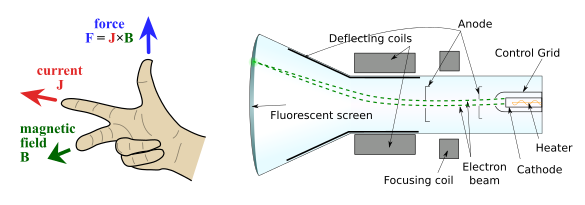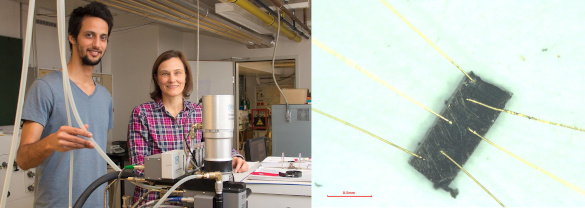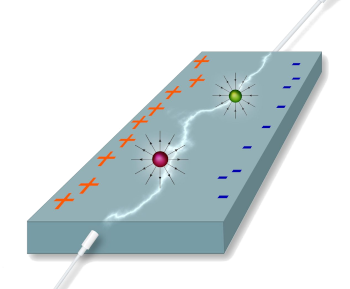Unusual Hall Effect
April 5, 2021
Just as the
baking soda and
vinegar reaction demonstrates a
chemical principle with
household items, there are household items that can be used in many
physics demonstrations.
Rubbing together
dissimilar materials will create an
electric charge that will attract small pieces of
paper.
Refrigerator magnets will attract and repel each other and act to attract some
materials like
steel paper clips, but not other materials like
plastic.

Reaction of baking soda (sodium bicarbonate) and vinegar (acetic acid) to produce sodium acetate, water and carbon dioxide. I did this reaction often as an elementary school student. (Created using Inkscape. Click for larger image.)
While there doesn't appear to be a commonality of the attraction of paper to a plastic
drinking straw and the
magnet holding a
child's artwork on the steel
door of a
refrigerator,
James Clerk Maxwell (1831-1879) in 1873 deduced that
electricity and
magnetism were manifestations of the same
force now called
electromagnetism. Electromagnetism is one of the
fundamental forces of
nature, the others being
gravity, the
strong nuclear force, and the
weak nuclear force.
As its name implies, the strong nuclear force is indeed strong, but it operates only at a length scale around the size of an
atomic nucleus. Gravity operates over an
infinite range, but it's strength is nearly forty
orders of magnitude (10
40) weaker than the nuclear force. Electromagnetism likewise has infinite range, but it's much stronger than gravity. It has a strength that's 1/137 that of the strong nuclear force. This strange
constant, 1/137, is the
fine structure constant that I wrote about in an
earlier article (The Fine Structure Constant, June 8, 2020).
The electromagnetic
coupling between electric charge and magnetism was the principle behind the operation of
cathode ray tubes (CRTs) in early
television and
computer displays. Magnetic
deflection of moving
electrons ("
cathode rays") allowed images to be "painted" onto a
phosphor screen (see figure). The
scanning electron microscope is another device that uses magnetic fields to
raster scan an
electron beam.

Movement of electrons in cathode rays is the equivalent of an electric current. When an electric current is acted upon by a magnetic field, the direction of the force is given by the so-called "right-hand rule," as shown on the left. The force is the cross product of the current and magnetic field. Magnetic deflection of electrons in a cathode ray tube is shown on the right. (Left image (modified) by Tokamac and right image (modified), both from Wikimedia Commons. Click for larger image.)
Magnetic fields also affect electron movement in
electrical conductors in a response known as the
Hall effect, discovered in 1879 by
American physicist,
Edwin Hall (1855-1938). Hall observed that when an electric current was passed through a
gold leaf conductor, a magnetic field
perpendicular to the current produced a
voltage (now known as the Hall Voltage)
transverse to the current.[1] His
experiment was a demonstration that electric currents were carried by electrons and not by
protons. The effect is caused by the
Lorentz force acting to pile more electrons on one side of the
metal strip than on the other, leading to a
potential difference between the two sides.

Excerpt from Edwin Hall's 1879 paper about the Hall effect. I always enjoy reading honestly written research accounts like this. Today, a paper written in this style would never be accepted for publication. (Archive.org image.[1])
Hall effect research has been celebrated by the
Nobel Prize in Physics in 1885 for the discovery of the
Quantum Hall effect by
Klaus von Klitzing (b. 1943); and in 1998 for the discovery of the
fractional quantum Hall effect. The quantum Hall effect has given us a
fundamental unit of
electrical resistance with the value 25812.80745
ohms.
A recent
open access paper at the
Proceedings of the National Academy of Sciences reports on the discovery of an unusual manifestation of the Hall effect in a
crystal of a
compound of
cerium,
bismuth and
palladium in which no magnetism is involved.[2-4] This research was conducted by an international team of physicists and
materials scientists from the
Vienna University of Technology (Vienna, Austria), the
Swiss Federal Institute of Technology (ETH, Zürich, Switzerland), the
Paul Scherrer Institut (Villigen, Switzerland),
McMaster University (Hamilton, Ontario, Canada), and
Rice University (Houston, Texas).[2]
Not only was the Hall effect observed without an applied magnetic field, it was especially strong.[2-4] It's reasoned that the electrons in this material behave as if it also contained
magnetic monopoles. According to
Maxwell's electromagnetic equations, magnetic monopoles should not exist. In analogy with electric charge that exists as individual
positive and negative units, a magnetic monopole would exist as an isolated
north or
south pole. As everyone knows, when you break a magnetic in half, you always get two new magnets with both poles, no monopoles.
This unusual non-magnetic Hall effect was discovered by
Sami Dzsaber, a
doctoral student at the Vienna University of Technology who was doing careful measurements on Ce
3Bi
4Pd
3, a
noncentrosymmetric crystal, for his
thesis.[2-3] The non-magnetic Hall effect wasn't just present, but it was huge, being orders of magnitude larger than expected.[2-3] It's been said that
extraordinary claims require extraordinary evidence, so further work was undertaken at the Paul Scherrer Institute in Switzerland using
muons as a probe for magnetism in the material at a
microscopic scale.[4] Such magnetism was not found, and this suggested that the effect was
topological.[4]

Left, Sami Dzsaber and Silke Bühler-Paschen in the laboratory at Vienna University of Technology. Right, a single crystal of the topological cerium, bismuth and palladium compound prepared for measurement of the novel Hall effect. (TU Wien images.[3] Click for larger image.)
Electrons in topological materials enter into
immutable quantum entanglement.[4] One class of topological materials are the
Weyl semimetals that contain a type of
quasiparticle known as a
Weyl fermion, and this new material appears to be a member of this class.[4] Some
layered semiconductors have demonstrated this kind of spontaneous Hall effect, but at a level that's a thousand times smaller.[4] Says
Professor Silke Bühler-Paschen of the the
Institute of Solid State Physics at the Vienna University of Technology in whose laboratory this discovery was made, "It's also important to note that you can't look at the electrons individually here - there are strong
quantum mechanical interactions between them."[3]
Although magnetic monopoles do not exist, this material behaves as if they are present and act upon the electrons.[3] The large Hall effect of this topological quantum device might be
technologically useful.[2] Such quantum devices might be used as
non-reciprocal elements to steer electrons in different directions.[3] This research was funded by the
Austrian Science Fund, the
European Union's Horizon 2020 Research and Innovation Program, the
Swiss National Science Foundation, the
National Science Foundation, the
Welch Foundation and
Los Alamos National Laboratory.[4]

Artist's conception of electron motion in the Ce3Bi4Pd3 Hall effect material. The material behaves as if magnetic monopoles are present.
(TU Wien image, also found here.)
![]()
References:
- E.H. Hall, "On a New Action of the Magnet on Electric Currents," American Journal of Mathematics, vol, 2 (1879), p.287-292.
- Sami Dzsaber, Xinlin Yan, Mathieu Taupin, Gaku Eguchi, Andrey Prokofiev, Toni Shirok, Peter Blah, Oleg Rubel, Sarah E. Gref, Hsin-Hua Lai, Qimiao Si, and Silke Paschen, "Giant spontaneous Hall effect in a nonmagnetic Weyl–Kondo semimetal," PNAS, vol. 118, no, 8 (2021), https://doi.org/10.1073/pnas.2013386118. This is an open access article with a PDF file here.
- Magnetic effect without a magnet, TU Wien Press Release, February 22, 2021.
- Jade Boyd, "Quantum quirk yields giant magnetic effect, where none should exist," Rice University Press Release, February 26, 2021.
Linked Keywords: Sodium bicarbonate; baking soda; vinegar; chemical reaction; chemistry; chemical principle; household; physics; rubbing; triboelectric effect; triboelectric series; dissimilar materials; electric charge; paper; refrigerator magnet; material; steel; paper clip; plastic; reaction of baking soda (sodium bicarbonate) and vinegar (acetic acid); sodium acetate; water; carbon dioxide; elementary school; student; Inkscape; drinking straw; magnet; child; artwork; door; refrigerator; James Clerk Maxwell (1831-1879); electricity; magnetism; force; electromagnetism; fundamental interaction; fundamental force; nature; gravity; strong interaction; strong nuclear force; weak interaction; weak nuclear force; atomic nucleus; infinity; infinite; orders of magnitude; physical constant; fine structure constant; alpha; coupling (physics); cathode ray tube; television set; computer monitor; computer display; deflection (physics); electron; cathode ray; phosphor; scanning electron microscope; raster scan; electron beam; electric current; magnetic field; force; right-hand rule; cross product; Tokamac; Wikimedia Commons; electrical conductor; Hall effect; America; American; physicist; Edwin Hall (1855-1938); gold leaf; perpendicular; voltage; transverse; experiment; proton; Lorentz force; metal; potential difference; scientific literature; paper; honesty; research; Archive.org; Nobel Prize in Physics; Quantum Hall effect; Klaus von Klitzing (b. 1943); fractional quantum Hall effect; base unit (measurement); fundamental unit; electrical resistance; ohm (unit); open access paper; Proceedings of the National Academy of Sciences of the United States of America; crystal; chemical compound; cerium; bismuth; palladium; materials science; materials scientist; Vienna University of Technology (Vienna, Austria); Swiss Federal Institute of Technology (ETH, Zürich, Switzerland); Paul Scherrer Institut (Villigen, Switzerland); McMaster University (Hamilton, Ontario, Canada); Rice University (Houston, Texas); magnetic monopole; Maxwell's electromagnetic equations; electrical polarity; positive and negative units; magnetic dipole; pole; Sami Dzsaber; postgraduate education; doctoral student; centrosymmetry; noncentrosymmetric; thesis; Sagan standard; extraordinary claims require extraordinary evidence; muon; microscopic scale; topological quantum field theory; laboratory; single crystal; immutable; quantum entanglement; Weyl semimetal; quasiparticle; Weyl spinor; Weyl fermion; heterojunction; layered semiconductor; professor; Silke Bühler-Paschen; quantum mechanics; quantum mechanical; technology; technological; reciprocity (electromagnetism); non-reciprocal; Austrian Science Fund; European Union's Horizon 2020 Research and Innovation Program; Swiss National Science Foundation; National Science Foundation; Robert A. Welch Foundation; Los Alamos National Laboratory; artist's impression; artist's conception.